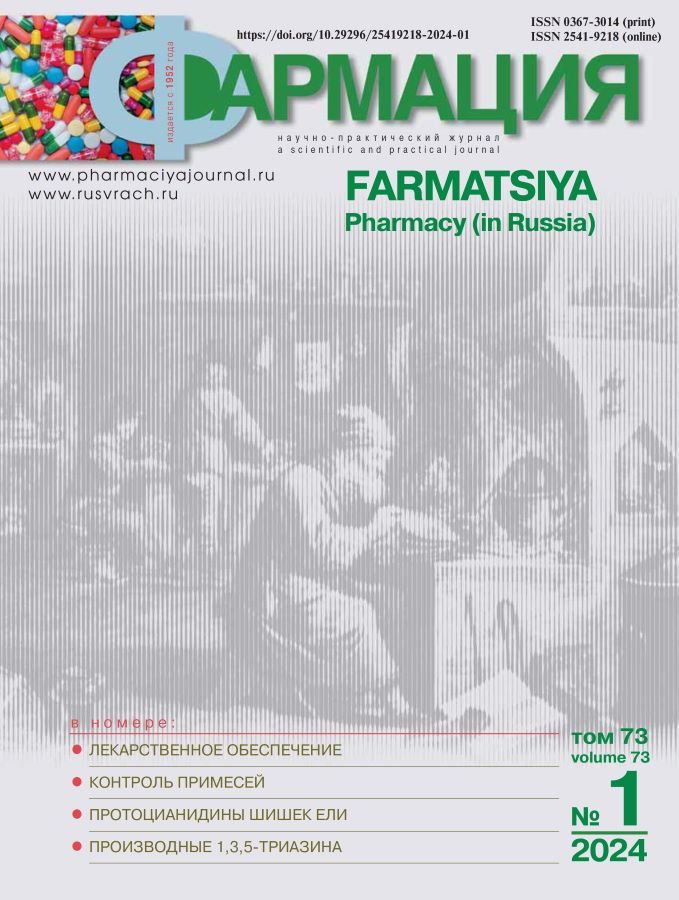Quantitative determination of procyanidins in spruce cones
- Authors: Semakin D.O.1, Gulyaev D.K.1, Belonogova V.D.1
-
Affiliations:
- Perm State Pharmaceutical Academy
- Issue: Vol 73, No 1 (2024)
- Pages: 5-9
- Section: Pharmaceutical chemistry and pharmacognosy
- URL: https://journals.eco-vector.com/0367-3014/article/view/626949
- DOI: https://doi.org/10.29296/25419218-2024-01-01
- ID: 626949
Cite item
Abstract
Introduction. The common spruce Picea abies (L.) of the pine family (Pinaceae) is a widespread woody plant. Fir cones are waste products of wood harvesting and seed harvesting by forestry. Also, cones are promising sources of biologically active substances.
Objective: to determine the content of procyanidins in spruce cones.
Material and methods. Spruce cones for the research were harvested on the territory of the Ilyinsky district of Perm Krai, which belongs to territories with low anthropogenic load. The preparation of samples for the study was carried out from July to March. The determination of the procyanidin content was carried out by the Porter method. Procyanidins during the reaction are oxidized to anthocyanins, colored red.
Results. Research was conducted to determine the optimal conditions for the extraction of procyanidins from spruce cones. The largest amount of procyanidins are extracted from raw materials when used as an extractant, ethyl alcohol 80%, when the raw materials are crushed to 0.5 mm, the ratio of raw materials and extractant is 1:30 and the extraction time is 40 minutes. The seasonal dynamics of the procyanidin content in spruce cones has been studied. It is established that the content of procyanidins is subject to seasonal fluctuations. The maximum content of procyanidins is observed in February, and the lowest content in July.
Conclusion. Optimal conditions for determining the content of procyanidins in spruce cones have been established. The dynamics of procyanidin accumulation in spruce cones harvested in different seasons of the year is determined. The content of procyanidins increases significantly in the autumn months and remains high until March.
Full Text
About the authors
Dmitry Olegovich Semakin
Perm State Pharmaceutical Academy
Email: semakin.dima98@gmail.com
ORCID iD: 0000-0001-9898-3479
Postgraduate student of the Department of Pharmacognosy
Russian Federation, Perm, Polevaya str., 2, 614990Dmitry Konstantinovich Gulyaev
Perm State Pharmaceutical Academy
Email: dkg2014@mail.ru
ORCID iD: 0000-0001-9464-1869
Associate Professor of the Department of pharmacognosy
Russian Federation, Perm, Polevaya str., 2, 614990Valentina Dmitrievna Belonogova
Perm State Pharmaceutical Academy
Author for correspondence.
Email: belonogova@pfa.ru
ORCID iD: 0000-0001-5193-3976
Head of the Department of Pharmacognosy
Russian Federation, Perm, Polevaya str., 2, 614990References
- Hofman T., Visi-Rajczi E., Levente A. Antioxidant properties assessment of the cones of conifers through the combined evaluation of multiple antioxidant assays. Industrial Crops and Products. 2019; 145: 111935–42. doi: 10.1016/j.indcrop.2019.111935.
- Hofman T., Levente A., Nemeth L., Vrsanska M., Schlosserova N., Vobercova S., Visi-Rajczi E. Antioxidant and antibacterial properties of Norway spruce (Picea abies H. Karst.) and Eastern Hemlock (Tsuga canadensis (L.) Carrière) cone extracts. Forests. 2021; 12 (9): 1189–211. doi: 10.3390/f12091189.
- Zhong H., Xue Y., Lu X., Shao Q., Cao Y., Wu Z., Chen G. The effects of different degrees of procyanidin polymerization on the nutrient absorption and digestive enzyme activity in mice. Molecules. 2018; 23 (11): 2916–27. doi: 10.3390/molecules23112916.
- Li S., Xu M., Niu Q., Xu S., Ding Y., Yan Y., Efficacy of procyanidins against in vivo cellular oxidative damage: a systematic review and meta-analysis. PLoS ONE. 2015; 10 (10): e0139455. doi: 10.1371/journal.pone.0139455.
- Jiang С., Zhu P., Shi Y., Xiang W., Ge S., Zhang Z., Zuo L. Protective effect of procyanidin B2 on intestinal barrier and against enteritis in a mouse model of trinitrobenzene sulphonic acid-induced colitis. J. South Med. Univ. 2019; 39 (7): 778–83. doi: 10.12122/j.issn.1673-4254.2019.07.05.
- Jie D.Z., Zhao J.F., Huang F., Sun G.L., Gao W., Lu Li., Xiao D.Q. Protective effect of procyanidin B2 on acute liver injury induced by aflatoxin B1 in rats. Biomed Environmental Science. 2020; 33 (4): 238–47. doi: 10.3967/bes2020.033.
- Goto M., Wakagi M., Shoji T., Takano-Ishikawa Y. Oligomeric procyanidins interfere with glycolysis of activated t cells. A novel mechanism for inhibition of T cell function. Molecules 2015; 20: 19014–26. doi: 10.3390/molecules201019014.
- Hofmann T., Levente A., Bocz B., Bocz D., Visi-Rajczi E. Cones of coniferous taxa as a potential source of bioactive polyphenols. Current Bioactive Compounds. 2022; 18 (6). doi: 10.2174/1573407218666211230144911.
- Shi L., Wang J., Yunkai L. Research progress on analysis methods of procyanidins. IOP Conf. Ser.: Earth Environ. Sci. 2021; 705 (1): 012006. doi: 10.1088/1755-1315/705/1/012006.
- Shivani Е., Sunita K. Seasonal changes in antioxidant enzymes, polyphenol oxidase enzyme, flavonoids and phenolic content in three leafy liverworts. Lindbergia. 2017; 40 (5): 39–44. doi: 10.25227/linbg.01076.
- Yang S., Liu X., He J., Liu M. Insight into seasonal change of phytochemicals, antioxidant, and anti-aging activities of root bark of Paeonia suffruticosa (Cortex Moutan) combined with multivariate statistical analysis. Molecules. 2021; 26 (20): 6102–21. doi: 10.3390/molecules26206102.
- Palmeri R., Siracusa L., Carrubba M., Parafati L., Proetto I., Pesce F., Fallico B. Olive leaves, a promising byproduct of olive oil industry: assessment of metabolic profiles and antioxidant capacity as a function of cultivar and seasonal change. Agronomy. 2022; 12 (9): 2007–16. doi: 10.3390/agronomy12092007.
- Rathore S., Mukhia S., Kapoor S., Bhatt V., Kumar R., Kumar R. Seasonal variability in essential oil composition and biological activity of Rosmarinus ofcinalis L. accessions in the western Himalaya. Scientifc Reports. 2022; 12 (1): 3305–18. doi: 10.1038/s41598-022-07298- x.
Supplementary files






